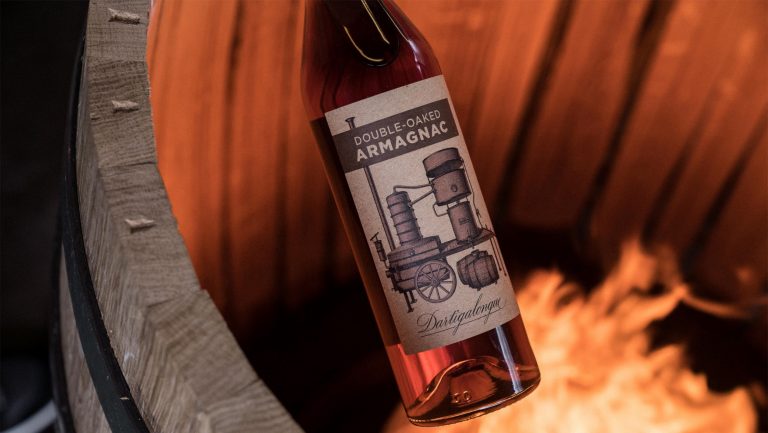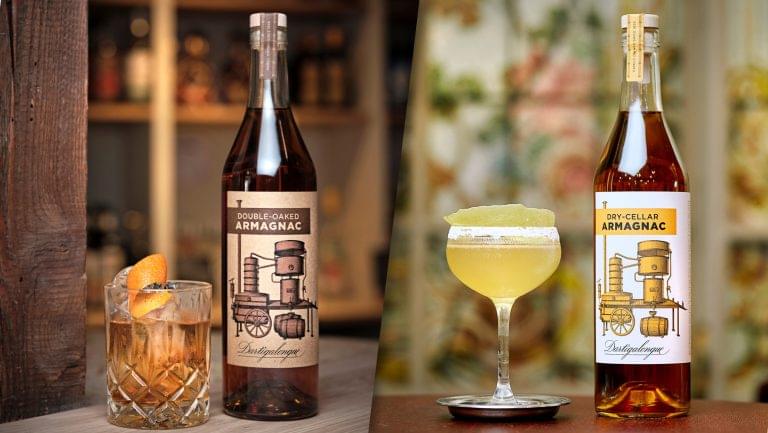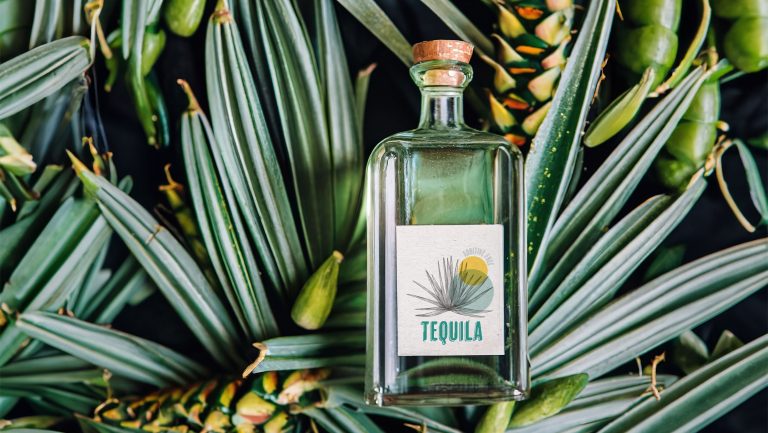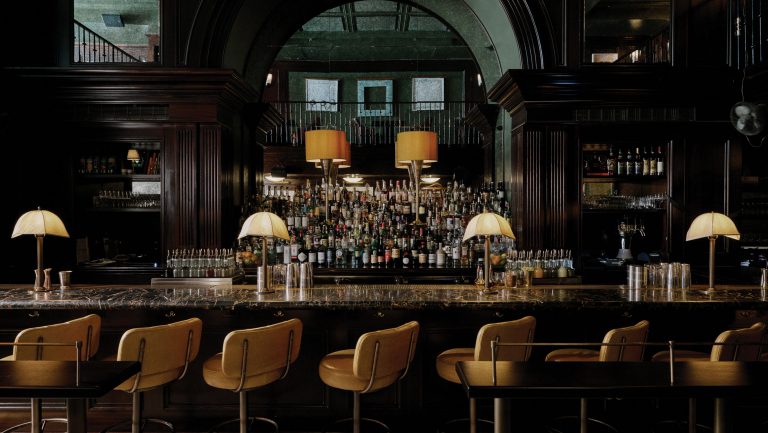Recently, a group of young street artists painted a massive mural on a water tower in the middle of vineyards in France’s Gascony province, the homeland of Armagnac. The area has a rich history that includes one of The Three Musketeers and culinary delicacies like foie gras, duck confit, and the inimitable canelé.
Armagnac embodies this history as one of the oldest French spirits, its production dating back centuries. Though the brandy’s long-established traditions could be a burden, there’s a new energy animating the category, driven by a new generation at the helm of classic brands. They are refining traditional Armagnacs while crafting new expressions that appeal to a new generation of drinkers.
This fresh perspective isn’t solely about the spirit in the bottle; it’s also informing the way that the region is presenting itself to the outside world. From commissioning murals from street artists to hosting musicians and breakdancers at local festivals, the new generation of Armagnac producers is inviting a wider audience to learn about Armagnac, which is key to finding new markets and pushing the category forward.

Don’t miss the latest drinks industry news and insights. Sign up for our award-winning newsletters and get insider intel, resources, and trends delivered to your inbox every week.
Traditional Distilling Meets Contemporary Culture
When Jérôme Delord and his brother Sylvain took over Armagnac Delord in 2001, they had a clear division of labor: Jérôme was the marketer while Sylvain was the “nose.” And they shared a clear idea of their mission. “We are not trying to change things,” explains Jérôme. “We are making Armagnac like it was done before … Nothing is revolutionary. It’s the same bottle, same stamps, it’s my father’s handwriting on the label.”
That speaks to the entire identity of Delord: Jérôme and Sylvain’s grandfather started as an itinerant distiller who towed his still behind his horses from farm to farm. Like most traditional producers, their bottles of barrel-aged Armagnac are the fruit of more than 100 years of distilling knowledge that they’ve honed into a fine craft. It is the product of wine made from local grapes that is slowly distilled in a single pass through a chauffe simple, or a small copper pot still with plates in the condensation column.
The union of the aromatics produced by that rather unique still with a long rest in oak barrels define Armagnac’s identity. Delord’s cellar contains bottles going back to 1904; today, there are bottles available for purchase that go back to the ’80s. Aficionados treasure these bottles for their flavors, aromas, and what they represent about tradition.

Benoit Hillion is similar to the Delord brothers in that he stepped into a family business and has been focused on carrying the tradition forward. He was a bit of an outsider because he married into the family, but since no one else was interested in taking over the business, the task fell to him. Hillion leads Dartigalongue, which is one of the oldest Armagnac houses, dating back to 1838. Like the Delords, he embraces that history, remaining focused on the barrel-aged expressions that continue to define Armagnac—though Hillion has made incremental changes to Dartigalongue’s process in order to gradually improve the spirit.
Why are traditional Armagnac producers like the Delord brothers, then, sponsoring murals like the one on the water tower? “Street art is a way of saying to everyone that we can be modern and [still] keep the tradition,” says Jérôme. That energy extends to their support for local music festivals featuring jazz and Balkan music, as well as Street’Art’Magnac, a local festival that embraces Armagnac and all of its counterintuitive connections with hip-hop culture. The annual festival, which follows the grape harvest in the fall, features breakdancing demonstrations, DJs, and a tour of local street art. Local murals celebrate everything from local Armagnac producers to abstract compositions.
The combination of traditional distilling and contemporary culture is only at odds superficially. It reflects distillers with a firm hand on traditional craft and a vision for new markets. By engaging with artists, musicians, and other creatives, the Delord brothers are taking a cue from the brash marketing strategies of the late 19th century that employed contemporary artists in the service of alcohol sales.
Using New Styles to Connect With New Markets
Despite remaining true to traditional methods of Armagnac production, the Delord brothers are managing to find small ways—and places—to innovate, such as with their Blanche Armagnac. When Armagnac comes out of the still it is clear, just like any other spirit; it’s the barrel aging that gives it the color and nuance that aficionados prize.
But the fresh, clear, unadulterated version has always had a place at local bars. It’s a fresh eau-de-vie, full of fruit-forward flavor, that is finding its way onto cocktail menus, bars, and—at least in Delord’s case—onto a huge shipment to South Korea. Jérôme says they had always sold some barrel-aged Armagnac to that market, but “our importer had never seen the white [Armagnac]. When he tasted the bottle, he bought 1,000 bottles.”

That global demand is helping to transform Armagnac in other ways. While Hillion continues crafting nuanced, barrel-aged Armagnac, he’s also keenly aware that there’s a limit to how much they can produce. Aging is a slow process that ties up investment and requires market projections decades into the future. That’s why he’s producing a new line of Armagnacs called Experience, which can be drunk very soon after production. “The potential for aged products is limited, so we focused on young Armagnac and cocktail segments,” says Hillion. “I’m proposing that the same thing can be enjoyed neat or in cocktails at an affordable price.”
Dartigalongue’s Experience line has a Blanche Armagnac as well as two other labels that highlight the house’s distinct heritage through different forms of aging. Their Dry Cellar Armagnac is aged for two years in the attics above their distillery, which tends to temper young brandy, while the Double-Oaked label is designed to appeal to fans of oak. Hillion’s goal is to appeal to a wide variety of drinkers with a trio of bottles that can be enjoyed straight or in a variety of cocktails, proving that “you don’t have to wait 15 to 20 years to make a good Armagnac,” he adds. In an interesting twist, this once again harkens back to tradition—Pierre Dartigalongue, who led the house in the middle of the 20th century, used a similar approach, printing up cocktail recipes that are the antecedents of every brand-driven cocktail handout of today.
Reconsidering the Name ‘Armagnac’
While Blanche Armagnac may sound like a great idea, not everyone is as sanguine about its prospects. “Blanche is an absolute waste of time [and] has been for 10 years.” says David Othenin-Girard, the spirits buyer for K&L Wine Merchants’ three California locations. “Nobody here wants this stuff, and considering the prices, it’s absolutely nuts that they’re still pushing it. It’s a total dead end.”
Nicholas Palazzi, the founder of the spirits import and distribution company, PM Spirits, which focuses on self-proclaimed “geeky” spirits, came to the same conclusion after trying to sell Blanche Armagnac. Ironically, one of Palazzi’s most successful recent projects is Cobrafire, a Blanche Armagnac with a label featuring a rearing cobra that conjures up associations with punk EP covers, tattoos, and ’70s-era kung fu movies. The label goes out of its way to proclaim that it’s an eau-de-vie de raisin (a spirit made from grapes), at a still strength of 51.9% ABV. The word “Armagnac” only appears on the back label in reference to the still type.
Palazzi tried selling Blanche Armagnac but, “when you come up with something called Blanche Armagnac, you assume that people know Armagnac. But here, no one knows what Armagnac is, so how do you plan on selling Blanche Armagnac? It’s the unnamed version of something that you don’t know anything about. How do you plan on selling that stuff?”
His sales pitch is pretty simple and familiar to the bar world: “We sell it as Cobrafire. ‘Hey, have you tried this? It’s really good. Have an ounce of Cobrafire and sip [it] with a beer as a chaser. You’ll see it’s good.’” And it really is Armagnac, un-aged and produced by Domaine d’Espérance in Bas Armagnac, where that house also makes its own line of traditionally aged Armagnacs.
Palazzi’s goal is a stealth campaign to get the world to love Armagnac, but because of the lack of familiarity with that name, he’s just focusing on an approachable brand. “These are Armagnacs, we just don’t call it Armagnac … It’s brandy, so we call it brandy. The main thinking is that with French brandy, people are overthinking things, and that gets in the way of drinking the thing.“

What’s Next for Armagnac?
Palazzi still loves Armagnac, the classic, barrel-aged version of Gascon tradition. It’s just that he’s focused on the same problem Delord and Dartigalongue are confronting: How to introduce it to drinkers who don’t know it. He sees a future for traditional, barrel-aged Armagnac in the U.S. based on the whiskey model. “People who were avid bourbon drinkers and collectors, who have been disappointed by shortages and price increases in American whiskey, are starting to look for something else,” says Palazzi. “If we and others are playing the right cards, there could really be a rise of Armagnac.”
Christine Foubert Cooney, who is responsible for more than 40 percent of all Armagnacs sold in the U.S. and imports both Delord and Dartigalongue through her company Heavenly Spirits, notes that one of the unexpectedly strong markets for Armagnac is Tennessee. She attributes this to the state’s concentration of bourbon drinkers who discover Armagnac and find a familiar flavor to fall in love with. Othenin-Girard also points to bourbon fans as potential Armagnac lovers, noting that they may be buying it because “they’ve been priced out of old spirits in their original categories.”
The growing focus on products that are based in local traditions and have distinct identities means that these attributes are frequently used as proxies for quality, which plays to Armagnac’s strengths. The spirit has a living tradition expressed clearly through the people who make it, but those producers are also global citizens who see how the world drinks today—and are trying to find entry points in the marketplace.
The world of Armagnac has something for everyone—whether that be the people who treasure classic, barrel-aged Armagnacs, bourbon drinkers who can’t find their old favorites, or bartenders looking for the next cool thing. Perhaps drinkers start their voyage with a younger, barrel-aged Armagnac. Perhaps they try an Armagnac in disguise with Palazzi’s Cobrafire. Either way, they’re headed in the same direction, and Armagnac can continue to refine its vaunted traditions while launching incremental innovations into new markets.

Dispatch
Sign up for our award-winning newsletter
Don’t miss the latest drinks industry news and insights—delivered to your inbox every week.
Max Garrone writes about wine, beer, and spirits and the cultures that create them. He cofounded Mezcalistas, where he is a contributing writer and continues to focus on the world of agave spirits.








